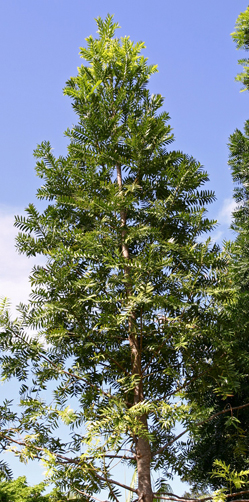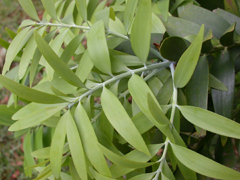 |
|
flickr.com/people/calamites/ |
 |
| flickr.com/people/tim-waters/ |
Translate this page:
Summary
Agathis moorei is a medium-sized evergreen tree with a rounded crown that grows up to 30 m in height and 60-120 cm in diameter. The leaves are usually 5-6 cm long and 8-12 mm broad and in decussate opposite pairs. It has an oval-shaped cone up to 15 cm long and 12 cm diameter that disintegrate at maturity to release the winged seeds. It is endemic to New Caledonia, Australia, and Pacific and is threatened by habitat loss due to overexploitation of timber. The seed is edible.
Also known as: Kaori Blanc, Kaori rouge
Physical Characteristics

 Agathis moorei is an evergreen Tree growing to 25 m (82ft) by 7 m (23ft) at a medium rate.
Agathis moorei is an evergreen Tree growing to 25 m (82ft) by 7 m (23ft) at a medium rate.
See above for USDA hardiness. It is hardy to UK zone 10 and is frost tender. The flowers are pollinated by Wind.
It is noted for attracting wildlife.
Suitable for: light (sandy), medium (loamy) and heavy (clay) soils, prefers well-drained soil and can grow in nutritionally poor soil. Suitable pH: mildly acid and neutral soils. It can grow in full shade (deep woodland) semi-shade (light woodland) or no shade. It prefers moist soil.
UK Hardiness Map
US Hardiness Map
Synonyms
Agathis corbassonii de Laub. Dammara lanceolata Vieill. Dammara moorei Lindl. Salisburyodendron corb
Plant Habitats
Edible Uses
Edible Parts: Seed
Edible Uses:
Seeds
References More on Edible Uses
Medicinal Uses
Plants For A Future can not take any responsibility for any adverse effects from the use of plants. Always seek advice from a professional before using a plant medicinally.
None Known
References More on Medicinal Uses
The Bookshop: Edible Plant Books
Our Latest books on Perennial Plants For Food Forests and Permaculture Gardens in paperback or digital formats.

Edible Tropical Plants
Food Forest Plants for Hotter Conditions: 250+ Plants For Tropical Food Forests & Permaculture Gardens.
More

Edible Temperate Plants
Plants for Your Food Forest: 500 Plants for Temperate Food Forests & Permaculture Gardens.
More

More Books
PFAF have eight books available in paperback and digital formats. Browse the shop for more information.
Shop Now
Other Uses
Containers Dye Fuel Furniture Lacquer Lighting Resin Varnish Waterproofing Wood
Agathis species in general yield a high-quality resin, often known as Manila Copal. The resins obtained from Agathis borneensis, Agathis dammara, Agathis lanceolata, Agathis macrophylla and Agathis philippinensis are the most important commercially, but all members of the genus yield useable quantities.
The resin is obtained in three forms. Firstly, it naturally exudes from the bark, branches, cones etc of the tree, especially as a result of any damage - some of these exudations can weigh as much as 20 kilos. The second form, known as fossil resin, is dug up from the ground - some of this resin can be of fairly recent origin (perhaps secreted by the roots of trees that have been felled, but much of it can be up to 50,000 years old, perhaps formed on a tree that fell naturally and was then gradually buried. The third form of resin is harvested by tapping the tree, though this can easily damage the tree and lead to premature death.
The resin has a range of applications. Traditionally it has been used as a fuel for campfires, a torch, as a waterproofing on boats, as a medicine, the smoke from the burning resin is used as a black dye and for tattooing. The resin is used commercially in making high-quality varnishes, lacquers, linoleum[64
].
The heartwood is a creamy-white or light yellow, often with a pink reflection, turning golden brown on exposure; it is not clearly demarcated from the 8 - 11cm wide band of heartwood. The texture is fine; the grain straight. The wood is light in weight, soft, not very durable, being susceptible to dry wood borers and termites, and moderately susceptible to fungi. The wood seasons well with only a slight risk of checking or distorting; once dried it is stable in service. It works well with normal tools; screwing and nailing are good; glueing is correct. The wood has a wide range of uses, including for cabinetwork and high-class furniture, interior panelling and joinery, turnery, woodware, light carpentry, boxes and crates, cooperage, veneer etc[848
].
Special Uses
Attracts Wildlife
References More on Other Uses
Cultivation details
Young plants grow better in the shelter and shade of the woodland, but require increasing amounts of light as they grow larger[418
]. High nitrogen fertilizer annually.
References Carbon Farming Information and Carbon Sequestration Information
Temperature Converter
Type a value in the Celsius field to convert the value to Fahrenheit:
Fahrenheit:
The PFAF Bookshop
Plants For A Future have a number of books available in paperback and digital form. Book titles include Edible Plants, Edible Perennials, Edible Trees,Edible Shrubs, Woodland Gardening, and Temperate Food Forest Plants. Our new book is Food Forest Plants For Hotter Conditions (Tropical and Sub-Tropical).
Shop Now
Plant Propagation
Seed - it cannot tolerate desiccation and does not store for much more than 2 months in normal conditions. It does not require pre-treatment. Sowing is done with the wing part of the seed pointing upwards and 66% of the seed buried in the soil. Germination commences within 6 days, with 90 - 100% germination rates within 10 days[325
].
Cuttings of leading shoots[307
].
Other Names
If available other names are mentioned here
Kaori Blanc, Kaori rouge
Native Range
PACIFIC: New Caledonia
Weed Potential
Right plant wrong place. We are currently updating this section.
Please note that a plant may be invasive in one area but may not in your area so it's worth checking.
Conservation Status
IUCN Red List of Threatened Plants Status : Vulnerable B1ab(i,ii,iii,iv,v); C1. Population severely fragmented. Continuing decline of mature individuals

Growth: S = slow M = medium F = fast. Soil: L = light (sandy) M = medium H = heavy (clay). pH: A = acid N = neutral B = basic (alkaline). Shade: F = full shade S = semi-shade N = no shade. Moisture: D = dry M = Moist We = wet Wa = water.
Now available:
Food Forest Plants for Mediterranean Conditions
350+ Perennial Plants For Mediterranean and Drier Food Forests and Permaculture Gardens.
[Paperback and eBook]
This is the third in Plants For A Future's series of plant guides for food forests tailored to
specific climate zones. Following volumes on temperate and tropical ecosystems, this book focuses
on species suited to Mediterranean conditions—regions with hot, dry summers and cool, wet winters,
often facing the added challenge of climate change.
Read More
Expert comment
Author
(Lindl.) Mast.
Botanical References
303325
Links / References
For a list of references used on this page please go here
Readers comment
| Add a comment |
|
If you have important information about this plant that may help other users please add a comment or link below. Only comments or links that are felt to be directly relevant to a plant will be included. If you think a comment/link or information contained on this page is inaccurate or misleading we would welcome your feedback at [email protected]. If you have questions about a plant please use the Forum on this website as we do not have the resources to answer questions ourselves.
* Please note: the comments by website users are not necessarily those held by PFAF and may give misleading or inaccurate information.
To leave a comment please Register or login here All comments need to be approved so will not appear immediately.
|
|